硕士论文格式规范要求
研究生学位论文格式规范_论文格式_

研究生学位论文格式规范学位论文是研究生申请硕士或博士学位的重要依据,是研究生从事科研工作的主要表现,它集中体现了作者在研究工作中获得的新的发明、理论或见解。
为了提高研究生学位论文的质量,做到学位论文格式规范化,特作如下规定:一、学位论文各部分内容要求研究生学位论文必须用汉语撰写(外国语相关专业除外)。
硕士学位论文(包含全日制硕士研究生、同等学力人员、中职硕士等)字数一般为3—5万;专业学位论文(包含教育硕士、公共管理硕士等)字数为2.5万以上;博士学位论文字数为8—10万。
论文内容应层次分明,数据可靠,文字简练,分析透彻,推理严谨,立论正确。
论文内容一般由13个主要部分组成,依次为:封面、扉页、中文摘要和关键词、英文摘要和关键词、目录、符号说明、论文正文、参考文献、注释、附录、致谢、攻读学位期间取得的研究成果、学位论文独创性声明和学位论文使用授权声明。
各部分的具体要求如下:1.封面:采用研究生学院规定的统一封面格式,封页上应填写论文题目、研究类型、作者姓名、年级、指导教师姓名、学科(专业)(指二级学科专业名称或专业学位方向)、论文提交日期、中图分类号等内容。
2.扉页:扉页内容包括论文题目、作者、申请学位类别和级别、学科专业、学位授予单位、指导教师、论文提交日期等。
3.中文摘要和关键词:中文摘要应简明概括论文的内容要点,包含论文的基本信息,体现研究课题的核心思想,明确论文的研究方法、研究成果和最终结论,并突出论文中具有创新性的部分。
硕士学位论文中文摘要字数为1000字左右,博士学位论文中文摘要为3000字左右。
关键词是为了文献标引工作从论文中选取的,用以标识全文主题内容信息的单词或术语,数量为3-6个,应尽量采用《汉语主题词表》提供的规范词。
4.英文摘要和关键词:英文摘要应与中文摘要的内容基本对应,要符合英语语法,语句通顺,文字流畅。
5.目录:目录是将正文内的章节标题依次排列。
6.符号说明:用于说明论文中符号表示的意义及单位(或量纲)。
硕士学位论文标准格式要求
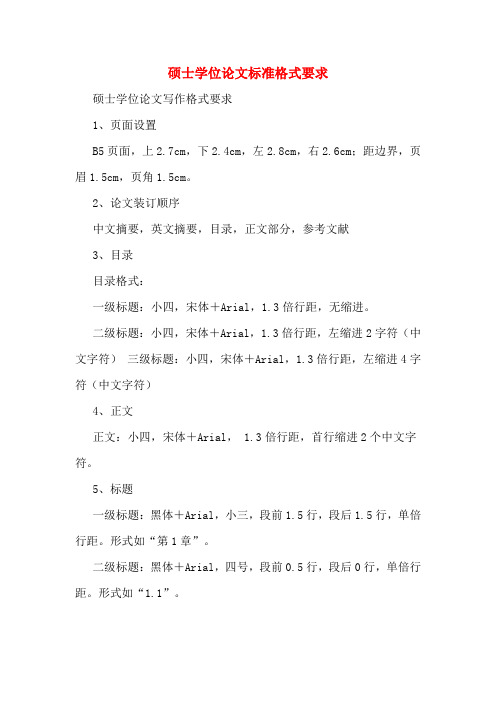
硕士学位论文标准格式要求硕士学位论文写作格式要求1、页面设置B5页面,上2.7cm,下2.4cm,左2.8cm,右2.6cm;距边界,页眉1.5cm,页角1.5cm。
2、论文装订顺序中文摘要,英文摘要,目录,正文部分,参考文献3、目录目录格式:一级标题:小四,宋体+Arial,1.3倍行距,无缩进。
二级标题:小四,宋体+Arial,1.3倍行距,左缩进2字符(中文字符)三级标题:小四,宋体+Arial,1.3倍行距,左缩进4字符(中文字符)4、正文正文:小四,宋体+Arial, 1.3倍行距,首行缩进2个中文字符。
5、标题一级标题:黑体+Arial,小三,段前1.5行,段后1.5行,单倍行距。
形式如“第1章”。
二级标题:黑体+Arial,四号,段前0.5行,段后0行,单倍行距。
形式如“1.1”。
三级标题:黑体+Arial,小四,段前0.75行,段后0行,1.3倍行距。
形式如“1.1.1”。
在二级标题和三级标题中,标题号和标题之间空两个格,例如: 3.2 催化重整固定床反应器综合数学模型3.2.1 基本微分方程组四级及以下标题:宋体、加黑、小四号字、1.3倍行距、段前0行、段后0行、首行缩进2字符6、表格(1)表格标题:段前0.5行,段后0行,单倍行距,黑体+Arial,居中,五号(2)表格正文:黑体+Arial,五号(3)表的格式为三线表,黑色单线形,线粗0.75磅。
(4)表中“-”表示未发现,“空白”表示未测或无此项,“0”代表实测结果确为零。
(5)表格中数字栏所有内容居中;最左侧项目栏中,不同项目左对齐,垂直居中;某一项目中的具体子项目水平和垂直方向均居中。
(6)表格要尽量紧挨正文说明部分。
表格格式如下:表3-1 原料油的主要性质HAGO HVGO加氢油 HVGO 项目914.1 962.8 密度(20 ℃),kg/m3 858.10.007 0.024 0.071 残炭,wt%260 278 340 平均分子量13.07 12.00 11.24 氢含量,wt%86.07 87.79 85.22 碳含量,wt%1.82 1.64 1.58 H/C原子比14.69 22.08 29.03 芳碳率,%烃类组成,wt%39.9 6.5 2.8 烷烃31.8 42.8 33.7 环烷烃28.3 50.7 55.8 芳香烃0 0 7.7 胶质+沥青质大庆常压重油906.9 4.300 577 13.11 86.52 1.82 10.9057.08 27.61 15.317、公式公式要按照下面的样式录入,公式要居中,公式编号为(3.1)或(3-1)形式,且该行要右对齐。
硕士、博士学位论文书写格式统一的要求与规范

硕士、博士学位论文书写格式统一要求研究生学位论文应用汉字撰写,硕士论文字数一般为3-4万,博士学位论文字数为5-6万字。
论文内容要文字简练,说明透彻,推理严谨,立论正确。
论文内容一般由十三个主要部分组成,依次为:1.中文封皮;2.英文封皮;3.独创性声明及版权授权书、4.目录;5.英文目录;6.中文摘要;7.英文摘要;8. 正文;9.参考文献;10.附录;11.致谢;12. 攻读学位期间发表的学术论文目录;13.论文图表统计。
1.论文封面(见附件1)农科类用绿色封皮,工科类用黄色封皮,理科类用灰色封皮,管理学用粉色封皮。
博士论文必须有书脊。
2. 独创性声明和关于论文使用授权的说明(见附件2)。
附于学位论文目录之前,需研究生和指导教师本人签字。
3.目录格式(见附件4)目###录(三号,黑体,居中)第一章xxxxx(四号,宋体)1.1xxxxx(小四,宋体) (1)1.1.1xxx(同上) (2)4.英文目录(参照中文)5.摘要格式(见附件4)1)中文摘要摘# #要(三号,黑体,居中)摘要正文(小四,宋体)摘要内容要包括目的、方法、结果和结论。
关键词: XXXX;XXXX;XXXX (3-5个主题词)(小四,黑体)格式、内容与中文摘要对应。
英文摘要必须用第三人称,最好采用现在时态编写。
英文关键词与中文关键词一一对应。
6. 纸型、页码及版心要求:论文开本及版芯论文开本大小:210mm×297mm(A4纸)版芯要求:左边距:25mm,右边距:25mm,上边距:30mm,下边距:25mm,页眉边距:23mm,页脚边距:18mm正文行间距:小四号字自然排版。
7.量和单位的使用必须符合国家标准规定,不得使用已废弃的单位如(高斯(G和Gg)、亩、克、分子浓度(M)、当量能度(N)等)。
量和单位不用中文名称,而用法定符号表示。
8.图表文中图、表名均须加注英文。
图、表标题中,中文采用五号黑体,英文采用五号Time New Roman 正体;表格中文字、图例说明采用小五号宋体;表注采用六号宋体。
硕士学位论文标准格式要求
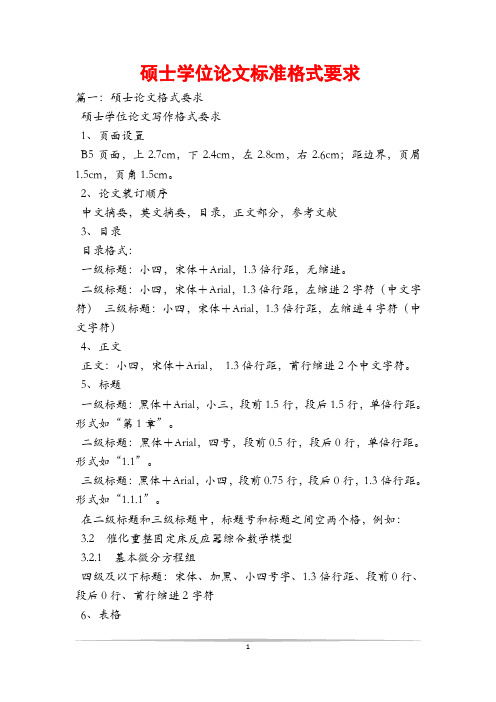
硕士学位论文标准格式要求篇一:硕士论文格式要求硕士学位论文写作格式要求1、页面设置B5页面,上2.7cm,下2.4cm,左2.8cm,右2.6cm;距边界,页眉1.5cm,页角1.5cm。
2、论文装订顺序中文摘要,英文摘要,目录,正文部分,参考文献3、目录目录格式:一级标题:小四,宋体+Arial,1.3倍行距,无缩进。
二级标题:小四,宋体+Arial,1.3倍行距,左缩进2字符(中文字符)三级标题:小四,宋体+Arial,1.3倍行距,左缩进4字符(中文字符)4、正文正文:小四,宋体+Arial,1.3倍行距,首行缩进2个中文字符。
5、标题一级标题:黑体+Arial,小三,段前1.5行,段后1.5行,单倍行距。
形式如“第1章”。
二级标题:黑体+Arial,四号,段前0.5行,段后0行,单倍行距。
形式如“1.1”。
三级标题:黑体+Arial,小四,段前0.75行,段后0行,1.3倍行距。
形式如“1.1.1”。
在二级标题和三级标题中,标题号和标题之间空两个格,例如:3.2 催化重整固定床反应器综合数学模型3.2.1 基本微分方程组四级及以下标题:宋体、加黑、小四号字、1.3倍行距、段前0行、段后0行、首行缩进2字符6、表格(1)表格标题:段前0.5行,段后0行,单倍行距,黑体+Arial,居中,五号(2)表格正文:黑体+Arial,五号(3)表的格式为三线表,黑色单线形,线粗0.75磅。
(4)表中“-”表示未发现,“空白”表示未测或无此项,“0”代表实测结果确为零。
(5)表格中数字栏所有内容居中;最左侧项目栏中,不同项目左对齐,垂直居中;某一项目中的具体子项目水平和垂直方向均居中。
(6)表格要尽量紧挨正文说明部分。
表格格式如下:表3-1 原料油的主要性质HAGO HVGO加氢油HVGO 项目914.1 962.8 密度(20 ℃),kg/m3 858.10.007 0.024 0.071 残炭,wt%260 278 340 平均分子量13.07 12.00 11.24 氢含量,wt%86.07 87.79 85.22 碳含量,wt%1.82 1.64 1.58 H/C原子比14.69 22.08 29.03 芳碳率,%烃类组成,wt%39.9 6.5 2.8 烷烃31.8 42.8 33.7 环烷烃28.3 50.7 55.8 芳香烃0 0 7.7 胶质+沥青质大庆常压重油906.9 4.300 577 13.11 86.52 1.82 10.9057.08 27.61 15.317、公式公式要按照下面的样式录入,公式要居中,公式编号为(3.1)或(3-1)形式,且该行要右对齐。
硕士毕业论文排版格式与书写格式
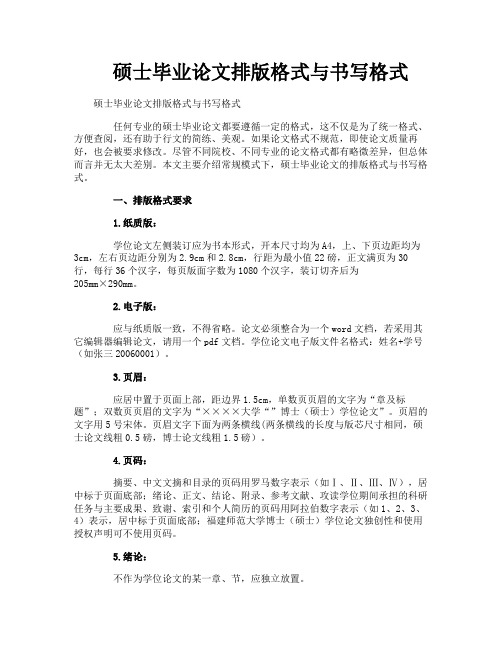
硕士毕业论文排版格式与书写格式硕士毕业论文排版格式与书写格式任何专业的硕士毕业论文都要遵循一定的格式,这不仅是为了统一格式、方便查阅,还有助于行文的简练、美观。
如果论文格式不规范,即使论文质量再好,也会被要求修改。
尽管不同院校、不同专业的论文格式都有略微差异,但总体而言并无太大差别。
本文主要介绍常规模式下,硕士毕业论文的排版格式与书写格式。
一、排版格式要求1.纸质版:学位论文左侧装订应为书本形式,开本尺寸均为A4,上、下页边距均为3cm,左右页边距分别为2.9cm和2.8cm,行距为最小值22磅,正文满页为30行,每行36个汉字,每页版面字数为1080个汉字,装订切齐后为205mm×290mm。
2.电子版:应与纸质版一致,不得省略。
论文必须整合为一个word文档,若采用其它编辑器编辑论文,请用一个pdf文档。
学位论文电子版文件名格式:姓名+学号(如张三20060001)。
3.页眉:应居中置于页面上部,距边界1.5cm,单数页页眉的文字为“章及标题”;双数页页眉的文字为“××××大学“”博士(硕士)学位论文”。
页眉的文字用5号宋体。
页眉文字下面为两条横线(两条横线的长度与版芯尺寸相同,硕士论文线粗0.5磅,博士论文线粗1.5磅)。
4.页码:摘要、中文文摘和目录的页码用罗马数字表示(如Ⅰ、Ⅱ、Ⅲ、Ⅳ),居中标于页面底部;绪论、正文、结论、附录、参考文献、攻读学位期间承担的科研任务与主要成果、致谢、索引和个人简历的页码用阿拉伯数字表示(如1、2、3、4)表示,居中标于页面底部;福建师范大学博士(硕士)学位论文独创性和使用授权声明可不使用页码。
5.绪论:不作为学位论文的某一章、节,应独立放置。
6.正文、结论:按章、节层次予以编排,每个章、节应添加标题。
因学科专业差异,有些学位论文的层次编排除章、节及标题外,还使用条、款及标题,在学位论文撰写时可视实际需要,灵活使用。
硕士研究生学位论文书写规范及论文版式要求
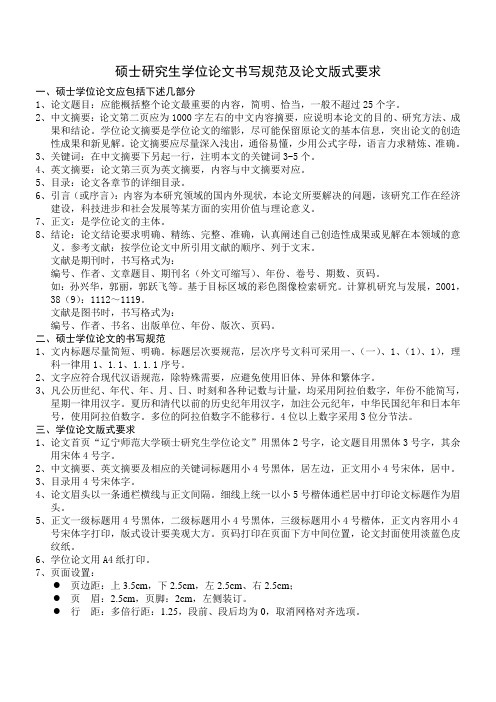
硕士研究生学位论文书写规范及论文版式要求一、硕士学位论文应包括下述几部分1、论文题目:应能概括整个论文最重要的内容,简明、恰当,一般不超过25个字。
2、中文摘要:论文第二页应为1000字左右的中文内容摘要,应说明本论文的目的、研究方法、成果和结论。
学位论文摘要是学位论文的缩影,尽可能保留原论文的基本信息,突出论文的创造性成果和新见解。
论文摘要应尽量深入浅出,通俗易懂,少用公式字母,语言力求精炼、准确。
3、关键词:在中文摘要下另起一行,注明本文的关键词3-5个。
4、英文摘要:论文第三页为英文摘要,内容与中文摘要对应。
5、目录:论文各章节的详细目录。
6、引言(或序言):内容为本研究领域的国内外现状,本论文所要解决的问题,该研究工作在经济建设,科技进步和社会发展等某方面的实用价值与理论意义。
7、正文:是学位论文的主体。
8、结论:论文结论要求明确、精练、完整、准确,认真阐述自己创造性成果或见解在本领域的意义。
参考文献:按学位论文中所引用文献的顺序、列于文末。
文献是期刊时,书写格式为:编号、作者、文章题目、期刊名(外文可缩写)、年份、卷号、期数、页码。
如:孙兴华,郭丽,郭跃飞等。
基于目标区域的彩色图像检索研究。
计算机研究与发展,2001,38(9):1112~1119。
文献是图书时,书写格式为:编号、作者、书名、出版单位、年份、版次、页码。
二、硕士学位论文的书写规范1、文内标题尽量简短、明确。
标题层次要规范,层次序号文科可采用一、(一)、1、(1)、1),理科一律用1、1.1、1.1.1序号。
2、文字应符合现代汉语规范,除特殊需要,应避免使用旧体、异体和繁体字。
3、凡公历世纪、年代、年、月、日、时刻和各种记数与计量,均采用阿拉伯数字,年份不能简写,星期一律用汉字。
夏历和清代以前的历史纪年用汉字,加注公元纪年,中华民国纪年和日本年号,使用阿拉伯数字。
多位的阿拉伯数字不能移行。
4位以上数字采用3位分节法。
三、学位论文版式要求1、论文首页“辽宁师范大学硕士研究生学位论文”用黑体2号字,论文题目用黑体3号字,其余用宋体4号字。
硕士学位论文格式设置

硕士学位论文格式设置【篇一:硕士学位论文格式】博士、硕士学位论文撰写格式为了规范博士、硕士学位论文的撰写,根据由国家标准局批准颁发的gb7713-87《科学技术报告、学位论文和学术论文的编写格式》,将博士、硕士学位论文的编写格式及有关标准统一规定如下:1 学位论文的装订封二、英文封二、声明和学位论文使用声明采用单页印刷,从中文摘要开始采用双面印刷。
正文中的一级标题(章目)用小3号加粗宋体,段前段后各空18磅,居左;二级标题(条)用4号加粗宋体,段前段后各空12磅,居左;三级标题(款)用小4号加粗宋体,段前段后各空6磅,居左;四级标题(项)同正文用小4号宋体,行距20磅。
数字和字母采用times new roman体。
样本详见附件。
学位论文格式为:( 注:页眉字体为小5号宋体) 奇数页眉博士/硕士论文奇数页码偶数页眉章节号和名偶数页码2 学位论文前置部分博士/硕士论文论文题目2.1 封面封面按统一的博士、硕士学位论文封面的内容和格式填写。
(见附件一,注:密级部分如:秘密、机密或绝密必须填,其余可不填。
密级后面★作标志,★后注明保密期限。
)书脊要注明学位论文题名及学位授予单位名称。
2.2 封二学位论文的封二可作为封面标识项目的延续,内容包括学位论文级别、题目、作者、指导教师、作者单位、出版时间等。
该页置于封面下面,包括中英文版,中文在前,英文在后。
字体和字号以封面为准。
见附件三和附件四。
2.3 声明另页起,用附件五,对其内容不得作任何改动。
该声明置于封二之后,中文摘要之前。
2.3 摘要摘要是学位论文内容的不加注释和评论的简短陈述,说明研究工作的目的、实验方法、实验结果和最终结论等。
应是一篇完整的短文,可以独立使用和引用,摘要中一般不用图表、化学结构式和非公知公用的符号和术语。
标题用3号宋体加粗,居中,正文用小4号宋体。
摘要分中、外两篇,硕士论文摘要中文字数400~600个字,博士论文摘要中文字数800~1000个字。
硕士学位论文撰写规范
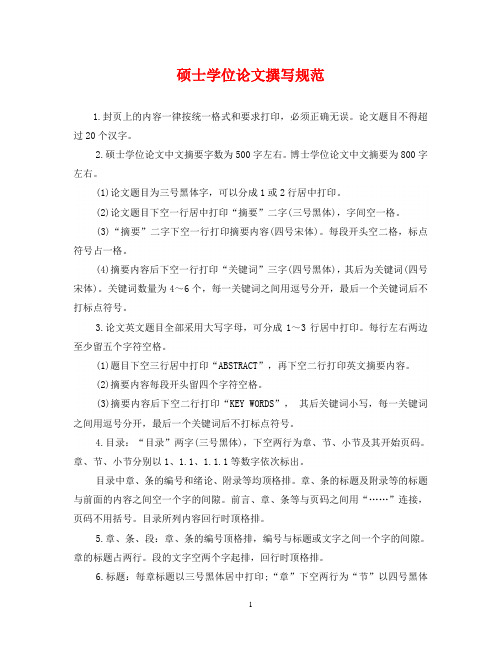
硕士学位论文撰写规范1.封页上的内容一律按统一格式和要求打印,必须正确无误。
论文题目不得超过20个汉字。
2.硕士学位论文中文摘要字数为500字左右。
博士学位论文中文摘要为800字左右。
(1)论文题目为三号黑体字,可以分成1或2行居中打印。
(2)论文题目下空一行居中打印“摘要”二字(三号黑体),字间空一格。
(3)“摘要”二字下空一行打印摘要内容(四号宋体)。
每段开头空二格,标点符号占一格。
(4)摘要内容后下空一行打印“关键词”三字(四号黑体),其后为关键词(四号宋体)。
关键词数量为4~6个,每一关键词之间用逗号分开,最后一个关键词后不打标点符号。
3.论文英文题目全部采用大写字母,可分成1~3行居中打印。
每行左右两边至少留五个字符空格。
(1)题目下空三行居中打印“ABSTRACT”,再下空二行打印英文摘要内容。
(2)摘要内容每段开头留四个字符空格。
(3)摘要内容后下空二行打印“KEY WORDS”,其后关键词小写,每一关键词之间用逗号分开,最后一个关键词后不打标点符号。
4.目录:“目录”两字(三号黑体),下空两行为章、节、小节及其开始页码。
章、节、小节分别以1、1.1、1.1.1等数字依次标出。
目录中章、条的编号和绪论、附录等均顶格排。
章、条的标题及附录等的标题与前面的内容之间空一个字的间隙。
前言、章、条等与页码之间用“……”连接,页码不用括号。
目录所列内容回行时顶格排。
5.章、条、段:章、条的编号顶格排,编号与标题或文字之间一个字的间隙。
章的标题占两行。
段的文字空两个字起排,回行时顶格排。
6.标题:每章标题以三号黑体居中打印;“章”下空两行为“节”以四号黑体左起打印;“节”下空一行为“小节”,以小四号或五号黑体左起打印。
换行后打印论文正文。
7.正文:采用小四号或五号宋体。
8.图:图包括曲线图、构造图、示意图、图解、框图、流程图、纪录图、布置图、地图、照片、图版等。
图应具有“自明性”,即只看图例,不阅读正文,就可理解图意。
硕士学位论文基本要求与写作规范
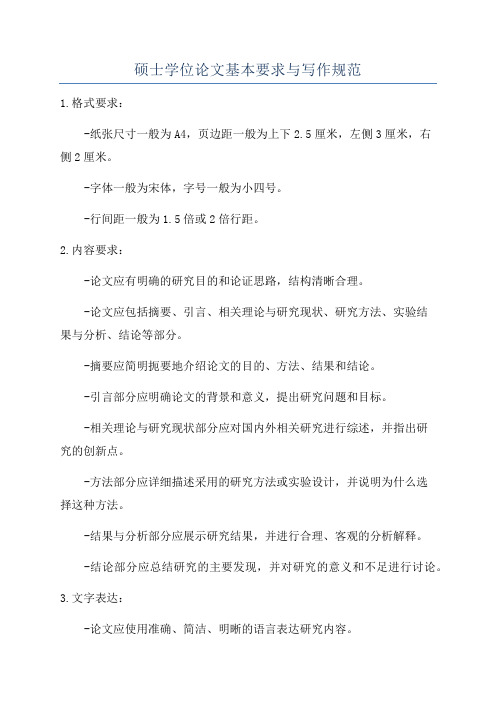
硕士学位论文基本要求与写作规范
1.格式要求:
-纸张尺寸一般为A4,页边距一般为上下2.5厘米,左侧3厘米,右
侧2厘米。
-字体一般为宋体,字号一般为小四号。
-行间距一般为1.5倍或2倍行距。
2.内容要求:
-论文应有明确的研究目的和论证思路,结构清晰合理。
-论文应包括摘要、引言、相关理论与研究现状、研究方法、实验结
果与分析、结论等部分。
-摘要应简明扼要地介绍论文的目的、方法、结果和结论。
-引言部分应明确论文的背景和意义,提出研究问题和目标。
-相关理论与研究现状部分应对国内外相关研究进行综述,并指出研
究的创新点。
-方法部分应详细描述采用的研究方法或实验设计,并说明为什么选
择这种方法。
-结果与分析部分应展示研究结果,并进行合理、客观的分析解释。
-结论部分应总结研究的主要发现,并对研究的意义和不足进行讨论。
3.文字表达:
-论文应使用准确、简洁、明晰的语言表达研究内容。
-避免使用口语化的表达方式,注意使用专业术语。
-注意语法和拼写错误,保持语言的规范性和准确性。
总而言之,硕士学位论文的基本要求是在研究规范要求下,准确、客观地陈述研究问题、方法、结果和结论,并遵循学术写作规范进行撰写。
在写作过程中要注意逻辑清晰,数据准确可信,文献引用规范,语言表达准确、简洁。
同时,建议根据所在学校或专业的要求,结合具体的研究对象和目的进行具体的论文写作。
硕士论文写作中的文字排版与格式要求

硕士论文写作中的文字排版与格式要求在硕士论文的写作过程中,文字排版与格式要求是非常重要的,它们对于整篇文章的呈现和阅读体验具有至关重要的影响。
本文将介绍硕士论文写作中常见的文字排版与格式要求,帮助研究生们正确地完成论文的撰写。
1. 硕士论文的页面设置在开始撰写硕士论文之前,需要针对页面进行合适的设置。
常见的页面设置包括纸张尺寸、页边距以及页眉、页脚的设置等。
一般情况下,标准的页面设置为A4纸,页边距为2.5厘米,页眉和页脚留白为2厘米。
通过适当的页面设置,可以使论文整体呈现出清晰、整洁的外观。
2. 字体与字号的选择在硕士论文的撰写过程中,字体和字号的选择非常重要。
一般来说,正文部分建议使用宋体、Times New Roman等常用的字体,并选择合适的字号,一般为小四号(12磅)。
标题部分可以选择稍微大一号的字号,如小三号(14磅),以突出标题的重要性。
此外,需要注意的是,整篇论文中字体和字号的一致性,避免出现混乱或者不一致的情况。
3. 行距与段落间距行距和段落间距的设置对于论文的整体美观和可读性同样具有重要的作用。
一般来说,行距选择为1.5倍行距或者2倍行距,以便于读者阅读和批注。
段落间距可以根据需要进行合理调整,一般建议在段落之间加入一个空行,以增加段落之间的空隙,使得文章结构更加清晰。
4. 标题的格式与层次在硕士论文中,标题具有重要的分节和组织作用,因此需要对标题的格式与层次进行统一和规范的设计。
一般来说,主标题使用粗体,居中对齐,并使用大三号或者小二号的字号;副标题可使用粗体或者斜体,居左对齐,并使用小四号或者小三号的字号。
此外,需要注意的是,标题之间的层次关系应该清晰可见,以方便读者快速地了解论文的结构和内容。
5. 图表的编号与标注在硕士论文中,图表的编号和标注是必不可少的。
一般来说,每个图表都应该有一个唯一的编号,并在论文正文中进行引用和解释。
图表的编号应该按照章节进行分组,如第一章的图表编号为 1.1、1.2等,第二章的图表编号为2.1、2.2等。
硕士学位论文格式要求

硕士学位论文格式要求
硕士学位论文是研究生阶段的重要学术成果,其格式要求是评审和答辩的首要
考量因素之一。
良好的格式规范不仅有利于突显研究生的学术水平和研究能力,同时也有助于提升论文的可读性和专业性。
本文将从论文封面、目录、正文组织结构、参考文献、致谢等方面介绍硕士学位论文的格式要求。
一、论文封面
硕士学位论文封面是整篇论文的开场,它需要包含以下内容: - 中文题目和英
文题目 - 论文提出者的姓名 - 导师的姓名 - 学校名称 - 时间
二、目录
目录是论文的纲要和脉络,其编排应该清晰明了,包含以下内容: - 绪论 - 文
献综述 - 研究方法 - 研究结果 - 讨论 - 结论 - 参考文献 - 附录
三、正文组织结构
硕士学位论文的正文结构应当合理,内容要求全面详实,一般包括: - 绪论:
介绍研究背景、目的和意义 - 文献综述:评述相关文献研究现状 - 研究方法:详细
描述研究过程和方法 - 研究结果:呈现研究实验结果和分析 - 讨论:对研究结果进
行分析和讨论 - 结论:总结论文研究工作并提出展望
四、参考文献
参考文献是论文中引用的资料来源,应当根据学术规范进行准确标注,包括:
- 期刊论文 - 会议论文 - 专著 - 网络资源
五、致谢
致谢部分是表达作者对参与论文撰写和研究工作提供帮助的个人和单位的感谢
之词,应当真诚表达感激之情。
综上所述,硕士学位论文格式要求至关重要,作者应当遵循学校和学术机构的
相关规范,力求做到内容完整、结构合理、表述清晰,从而展现出研究生的学术水平和专业素养,为论文的顺利评审和答辩奠定基础。
硕博学位论文格式要求_论文格式_

硕博学位论文格式要求学位论文是学位授予单位研究生培养质量的重要标志,是研究生本人在学期间从事科学研究的成果体现,是对研究生综合能力的考核,是研究生申请学位的主要依据。
为保证我校研究生学位论文的质量,实现我校学位论文格式的规范化,特制定《天津大学关于博士、硕士学位论文统一格式的规定》。
1、论文结构要求学位论文应采用汉语撰写;一般由十一部分组成,依次为:(1)封面,(2)扉页,(3)独创性声明、学位论文使用授权说明,(4)中文摘要,(5)英文摘要,(6)目录,(7)正文,(8)参考文献,(9)发表论文和参加科研情况说明,(10)附录,(11)致谢。
各部分具体要求如下:(1) 封面(采用天津大学统一印制的封面)论文题目:应是整个论文总体内容的体现,要引人注目,力求简短,严格控制在25字以内。
学科专业:以国务院学位委员会发布的学科专业目录中的二级学科为准。
指导教师:除工程硕士写两名指导教师外(含一名企业导师),其他一般只能写一名指导教师。
(2)扉页(见样例)(3)独创性声明和论文使用授权说明:《独创性声明》和《学位论文版权使用授权书》里的“学位论文作者签名”和“导师签名”均不能为空,否则不提交校学位评定委员会讨论学位。
(见样例)(4)中文摘要中文摘要应将学位论文的内容要点简短明了地表达出来,约500~800字左右(限一页),字体为宋体小四号。
内容应包括工作目的、研究方法、成果和结论。
要突出本论文的创新点,语言力求精炼。
为了便于文献检索,应在本页下方另起一行注明论文的关键词(3-7个)。
(见样例)(5)英文摘要内容应与中文摘要相同。
字体为Times New Roman小四号。
(见样例)(6)目录标题应简明扼要并标明页号。
(7)正文硕士学位论文一般要求不少于3万字;博士学位论文一般不少于5万字。
内容一般包括:国内外研究现状、理论分析、计算方法、实验装置和测试方法、实验结果分析与讨论、研究成果、结论及意义。
(8)参考文献只列出作者直接阅读过、在正文中被引用过的文献资料。
硕士学位论文格式与基本规范(标准版)9篇

硕士学位论文格式与基本规范(标准版)第1篇硕士学位论文格式与基本规范(标准版)为进一步提高我校的硕士学位论文规范程度,参考其他高校的相关要求,对原《中国青年政治学院硕士学位论文格式与基本规范》进行修订完善。
学位论文是研究生培养质量和学术水平的集中体现。
高质量、高水平的学位论文在选题和内容上要有创造性和创新性,而且在表达方式上应具有规范性和严谨性。
本规范适用于具有中国青年政治学院正式学籍的全日制研究生、专业学位研究生的学位论文。
提交评议和答辩的学位论文由封面、独创性声明及版权授权书、中文摘要、英文摘要、目录、插图和附表清单、论文正文、参考文献、附录、致谢等部分组成并按先后顺序排列。
硕士学位论文封面(见附件一)、书脊(见附件三)要求如下:(1)论文题目:不超过26个字,可分两行排列,中英文对照。
(2)指导教师:论文作者本人导师。
未经学院学位评定委员会遴选且在研究生处备案的合作指导教师,不得在学位论文上署名;署名的合作指导教师人数不超过2人。
(3)学科门类:专业所属的学科门类,如哲学、经济学、法学、理学、管理学等。
(4) 专业名称、研究方向:应严格按照专业目录和培养方案填写。
(6) 论文封面颜色由专业点自定,各专业可选择不同的颜色以示区别。
2.独创性声明和关于论文使用授权的说明附于学位论文摘要之前,需研究生和指导教师本人签字。
见附件二。
硕士论文摘要一般为500-1000字。
内容包括研究工作目的、研究方法、所取得的结果和结论,应突出本论文的创造性成果或新见解,语言精炼。
摘要应当具有独立性,即不阅读论文的全文,就能获得论文所能提供的主要信息。
见附件三。
在论文摘要后另起一行注明本论文的关键词(3-5个)。
一般列至二级标题,必须与正文标题一致。
论文中如果图、表较多,可以分别列出清单列于目录页之后。
图表的清单应有序号、图表名称和页码。
字数一般不少于3万。
论文正文是文章的主体,一般由标题、文字叙述、图表、公式和数据等部分构成。
硕士论文排版
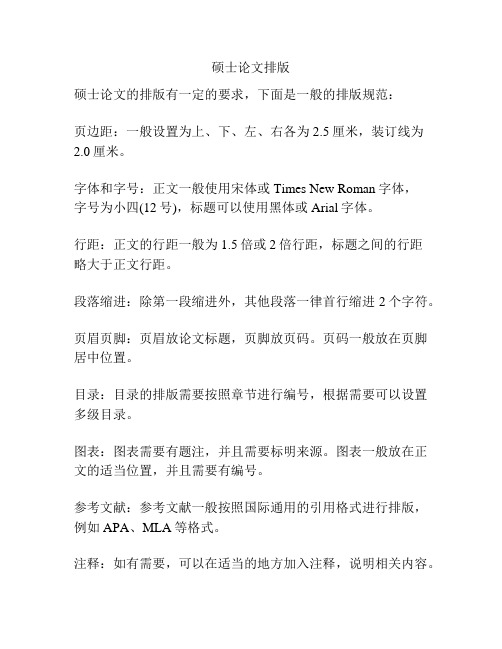
硕士论文排版
硕士论文的排版有一定的要求,下面是一般的排版规范:
页边距:一般设置为上、下、左、右各为2.5厘米,装订线为2.0厘米。
字体和字号:正文一般使用宋体或Times New Roman字体,
字号为小四(12号),标题可以使用黑体或Arial字体。
行距:正文的行距一般为1.5倍或2倍行距,标题之间的行距
略大于正文行距。
段落缩进:除第一段缩进外,其他段落一律首行缩进2个字符。
页眉页脚:页眉放论文标题,页脚放页码。
页码一般放在页脚居中位置。
目录:目录的排版需要按照章节进行编号,根据需要可以设置多级目录。
图表:图表需要有题注,并且需要标明来源。
图表一般放在正文的适当位置,并且需要有编号。
参考文献:参考文献一般按照国际通用的引用格式进行排版,例如APA、MLA等格式。
注释:如有需要,可以在适当的地方加入注释,说明相关内容。
除了上述基本的排版规范外,具体的排版要求也可能根据不同学校或教师的要求而有所差异。
因此,在开始排版之前,一定要仔细查阅学校或教师给出的排版指南,并按照指南进行排版。
硕士论文格式要求
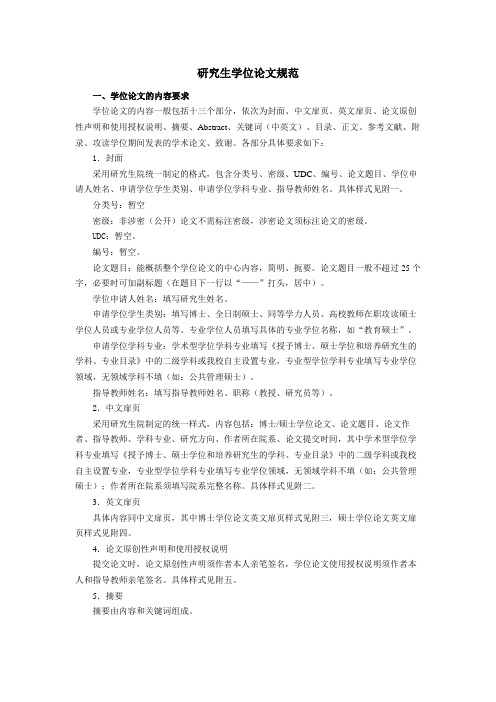
研究生学位论文规范一、学位论文的内容要求学位论文的内容一般包括十三个部分,依次为封面、中文扉页、英文扉页、论文原创性声明和使用授权说明、摘要、Abstract、关键词(中英文)、目录、正文、参考文献、附录、攻读学位期间发表的学术论文、致谢。
各部分具体要求如下:1.封面采用研究生院统一制定的格式,包含分类号、密级、UDC、编号、论文题目、学位申请人姓名、申请学位学生类别、申请学位学科专业、指导教师姓名。
具体样式见附一。
分类号:暂空密级:非涉密(公开)论文不需标注密级,涉密论文须标注论文的密级。
UDC:暂空。
编号:暂空。
论文题目:能概括整个学位论文的中心内容,简明、扼要。
论文题目一般不超过25个字,必要时可加副标题(在题目下一行以“——”打头,居中)。
学位申请人姓名:填写研究生姓名。
申请学位学生类别:填写博士、全日制硕士、同等学力人员、高校教师在职攻读硕士学位人员或专业学位人员等。
专业学位人员填写具体的专业学位名称,如“教育硕士”。
申请学位学科专业:学术型学位学科专业填写《授予博士、硕士学位和培养研究生的学科、专业目录》中的二级学科或我校自主设置专业,专业型学位学科专业填写专业学位领域,无领域学科不填(如:公共管理硕士)。
指导教师姓名:填写指导教师姓名、职称(教授、研究员等)。
2.中文扉页采用研究生院制定的统一样式,内容包括:博士/硕士学位论文、论文题目、论文作者、指导教师、学科专业、研究方向、作者所在院系、论文提交时间,其中学术型学位学科专业填写《授予博士、硕士学位和培养研究生的学科、专业目录》中的二级学科或我校自主设置专业,专业型学位学科专业填写专业学位领域,无领域学科不填(如:公共管理硕士);作者所在院系须填写院系完整名称。
具体样式见附二。
3.英文扉页具体内容同中文扉页,其中博士学位论文英文扉页样式见附三,硕士学位论文英文扉页样式见附四。
4.论文原创性声明和使用授权说明提交论文时,论文原创性声明须作者本人亲笔签名,学位论文使用授权说明须作者本人和指导教师亲笔签名。
硕士学位论文格式统一规定
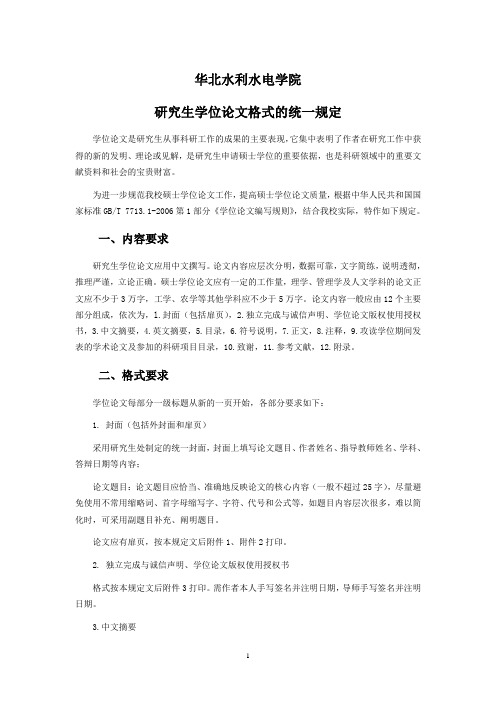
华北水利水电学院研究生学位论文格式的统一规定学位论文是研究生从事科研工作的成果的主要表现,它集中表明了作者在研究工作中获得的新的发明、理论或见解,是研究生申请硕士学位的重要依据,也是科研领域中的重要文献资料和社会的宝贵财富。
为进一步规范我校硕士学位论文工作,提高硕士学位论文质量,根据中华人民共和国国家标准GB/T 7713.1-2006第1部分《学位论文编写规则》,结合我校实际,特作如下规定。
一、内容要求研究生学位论文应用中文撰写。
论文内容应层次分明,数据可靠,文字简练,说明透彻,推理严谨,立论正确。
硕士学位论文应有一定的工作量,理学、管理学及人文学科的论文正文应不少于3万字,工学、农学等其他学科应不少于5万字。
论文内容一般应由12个主要部分组成,依次为,l.封面(包括扉页),2.独立完成与诚信声明、学位论文版权使用授权书,3.中文摘要,4.英文摘要,5.目录,6.符号说明,7.正文,8.注释,9.攻读学位期间发表的学术论文及参加的科研项目目录,10.致谢,11.参考文献,12.附录。
二、格式要求学位论文每部分一级标题从新的一页开始,各部分要求如下:1. 封面(包括外封面和扉页)采用研究生处制定的统一封面,封面上填写论文题目、作者姓名、指导教师姓名、学科、答辩日期等内容;论文题目:论文题目应恰当、准确地反映论文的核心内容(一般不超过25字),尽量避免使用不常用缩略词、首字母缩写字、字符、代号和公式等,如题目内容层次很多,难以简化时,可采用副题目补充、阐明题目。
论文应有扉页,按本规定文后附件1、附件2打印。
2. 独立完成与诚信声明、学位论文版权使用授权书格式按本规定文后附件3打印。
需作者本人手写签名并注明日期,导师手写签名并注明日期。
3.中文摘要应概括地反映出本论文的主要内容,具有独立性和自含性,包括研究工作目的、方法、结果和结论,要突出本论文的创造性成果。
摘要字数一般在300-600字左右。
关键词是为了便于做文献检索和检索工作而从论文中选取出来用以表示全文主题内容信息的单词或术语,应尽量采用《汉语主题词表》或各专业主题词表提供的规范词。
硕士毕业论文格式标准
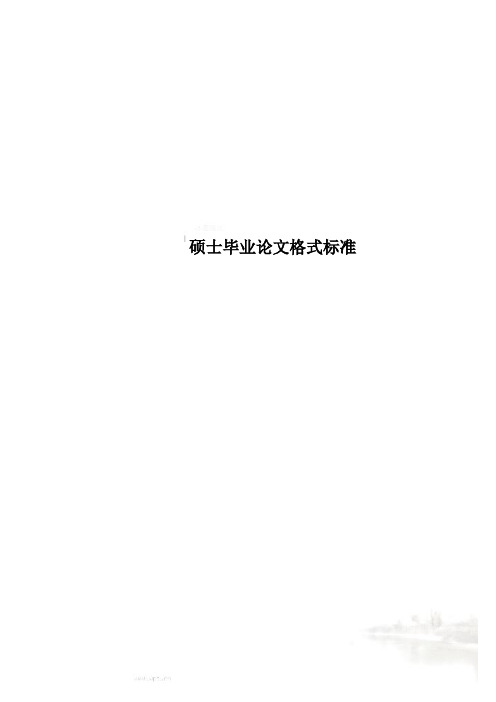
硕士毕业论文格式标准硕士毕业论文格式标准【篇一:硕士论文格式标准与要求】硕士论文格式标准与要求自上次介绍了本科毕业论文的格式要求之后,今天亿智天下文化传媒又对硕士毕业论文的格式和规范要求做了详细的阐述,以给硕士论文的撰写者提供一点帮助,提高毕业论文的质量和水平。
硕士毕业论文主要由封面、独创性声明及版权授权书、中文摘要、英文摘要、目录、插图和附表清单、论文正文、参考文献、附录、致谢组成,且各个部分按以上的先后顺序排列。
下面就对每个部分的基本要求、格式要求进行详细说明。
一、硕士毕业论文的基本要求1.封面硕士毕业论文的封面由论文题目、指导教师、学科门类、专业名称/研究方向、日期、封面颜色等部分组成,其中:(1)论文题目论文题目字数不应超过26个汉字,可以分两行排列,及中英文对照。
(2)指导教师填写论文作者的指导教师。
没有经过学校相关规定批准的合作指导教师,是不允许在论文上署名的,且署名的合作指导教师人数不超过2人。
(3)学科门类:论文编写者的专业所属的学科门类,例如工学、文学、哲学、经济学、法学、理学、管理学等。
节、小节分别以1、1.1、1.1.1、1.1.2、2、2.1等数字依次标出,一二级目录用小四宋体,三级目录用5号宋体,数字及英文字符采用times new roman格式。
5.插图及表格论文中如果涉及到较多的图、表,可以给出一个清单,附于目录页之后。
图表的清单应有序号、图表名称和页码。
6.正文论文正文的字数一般至少3万,它是文章的主体,分为标题、文字叙述、图表、公式和数据等部分,文章组织形式可结合学科实际的要求和研究课题的特点而定。
7.参考文献参考文献是在研究本课题的过程中,对某一著作或者论文的整体参考与引用。
8.附录在论文的编写过程中,对于不适宜放入正文中的部分,但确实与本论文研究有关的过程或资料均应该放在附录中,以免影响到论文主体的结构或者论点。
9.致谢致谢部分主要用于答谢对课题研究、毕业论文完成等方面有较重要帮助的人员。
硕士学位论文格式要求及审查要点

硕士学位论文格式要求及审查要点哈尔滨工业大学深圳研究生院硕士学位论文格式要求及审查要点说明:此《硕士学位论文格式要求及审查要点》根据《哈工大研究生学位论文撰写规范》编写制定,重点考虑往届学生易出错的地方,仅供我院研究生撰写学位论文时参考使用。
如有遗漏之处或与《撰写规范》不一致之处,以《撰写规范》为准。
特别感谢本要点的原始作者徐文福老师。
1 正文前的部分1.1 标题(1)字数不超过25字;若有副标题,则正标题+副标题字数不超过35字;(2)英文标题:封面及扉页均全大写;(3)采用名词性短语,不含标点符号;(4)标题字号应为黑体二号,且应注意中、英文标题之间以及作者名称之间的行间距。
1.2 首页及扉页(1)所在单位:深圳研究生院,Shenzhen Graduate School(在职工程硕士按实际所在单位填写);(2)用“Dissertation”不用“Thesis”;(3)工学硕士用“Master Degree in Engineering”;工程硕士用“Master’s Degreeof Engineering”;(4)学校代码和密级的冒号应该对齐。
1.3 目录(1)目录里的“ABSTRACT”可以写成“Abstract”;(2)目录章节编号要求编到3级标题,即X.X.X;(3)英文摘要标题首字母大写“Abstract”。
1.4 摘要(1)为独立短文,不用“首先、其次、然后……”或“(1)、(2)、(3)……”;(2)摘要字数500~1000字,应主要反映课题研究背景,研究问题,解决方法及评估结果;(3)英文摘要做到无病句,无语法错误,尽量用简短句式,而不是复合句、长句型。
1.5 关键词(1)3~6个;(2)中文关键词用分号“;”分开;(3)英文用关键词逗号“,”,且所有字母小写。
2 排版要求2.1 页面设置(版芯)(1)A4标准纸(210mm?297mm);(2)版芯:150mm?(240mm±2mm),包括页眉、页码,每页约33行,33列;(3)行距:章标题上、下行距10mm(段前一行、段后0.8行);节标题上、下行距7-8mm(段前0.5行、段后0.5行);条标题上、下行距6-7mm(段前0.5行、段后0.5行);款标题上、下行距3-4mm(段前0.0行、段后0.0行)。
博士、硕士学位论文写作规范

博士、硕士学位论文写作规范随着高等教育的普及,越来越多的学生选择攻读硕士、博士学位。
而论文是攻读学位过程中不可或缺的一部分,因此,写作规范对于学位论文的通过非常重要。
本文将从格式、文献引用、语言表达等方面介绍硕士、博士学位论文的写作规范。
一、格式规范1.页码与页眉页脚论文的页码、页眉和页脚要从第一页开始编排,编排方式是阿拉伯数字,一般位于页面的右下角。
页眉和页脚应正确显示论文的名称和作者姓名,以及页面编号。
2.封面论文的封面包括题目、作者、指导教师、所属学院、学校名称等基本信息,并附有学位论文评议书。
封面上的信息必须准确完整。
3.目录目录是论文的重要组成部分,应包含所有章节和子章节的标题以及页码。
目录格式应统一,层次分明,字体清晰易懂。
目录应在第一页之后,从第二页开始编排。
二、文献引用规范1.引用格式学位论文的引用格式要求规范,尤其是文献引用的格式,一定要符合规范。
国内外通行的引用格式主要有APA和MLA两种。
其中,APA一般适用于社会科学、教育科学等领域的论文,而MLA则适用于人文社会科学领域的论文。
因此,要根据实际情况选择适当的引用格式。
2.参考文献参考文献是学位论文的重要组成部分,必须准确无误地列出每一篇引用的文献。
参考文献格式一般为作者、论文题目、期刊名称、发表时间等。
不同的学科领域可能有不同的文献参考格式,一定要查阅相关资料并按照规范格式写作。
三、语言表达规范1.表述准确语言表达要求准确、清晰明了,给人以准确、科学、自然的感觉。
论文中的文字和术语尽量应该通俗易懂,同义词、概念、术语不应混淆。
2.避免复制粘贴学位论文的撰写必须遵守学术道德规范,不得抄袭、剽窃他人论文,不得直接抄录资料、图表等信息。
同时,论文撰写要注意避免使用过多的副词、短语等,使文章的表述更为简明扼要,容易竖立出清晰的思路。
结论:硕士、博士学位论文是学生攻读学位的重要阶段,论文的写作规范在论文审核和评审中起着至关重要的作用。
- 1、下载文档前请自行甄别文档内容的完整性,平台不提供额外的编辑、内容补充、找答案等附加服务。
- 2、"仅部分预览"的文档,不可在线预览部分如存在完整性等问题,可反馈申请退款(可完整预览的文档不适用该条件!)。
- 3、如文档侵犯您的权益,请联系客服反馈,我们会尽快为您处理(人工客服工作时间:9:00-18:30)。
硕士论文格式规范一、正式论文项目顺序1.封面(Cover)2.标题页(Title Page)3.鸣谢(Acknowledgements)4.中文摘要(Abstract in Chinese)5.英文摘要(Abstract in English)6.目录页(Contents)7.正文(从“Introduction” 到“Conclusion”, 其中包含尾注或脚注)8.参考文献(Bibliography)二、规范详解1.封面学校统一发放。
2.标题页论文标题应符合英文的思维习惯,一般不使用冠词,力求简洁易懂。
标题文字全部大写。
标题页的每一行文字均居中,一律为四号字,粗体显示。
Shanghai International Studies UniversityGENDER IN CANADIAN FEMINIST TRANSLATION STUDIESA ThesisSubmitted to Graduate School and College of EnglishIn Partial Fulfillment of Requirements forDegree of Master of ArtsByHan ZhongyiUnder Supervision of Professor Feng QinghuaNovember 20083.鸣谢行文语气要严肃敬重,内容须紧扣论文和学术的前后过程,切忌离题,避免主客倒置。
“Acknowledgement s”必须为复数形式。
鸣谢页不须标注页码。
4.摘要4.1 摘要必须概括论文的主要内容,突出论文的创新点。
4.2 内容要少而精,一般不超过一页,切忌铺延漫谈。
4.3 页尾提供的关键词不宜过多,一般为3-5个。
关键词要能反映学术研究的关键连接点,以方便作相关课题的检索。
5.目录页目录分级(即子目录)不宜过粗或过细,一般为二至三级。
目录不宜过长,一般不超过两页。
编排目录页时,须用Word所提供的目录编辑工具进行操作。
ContentsAcknowledgementsAbstract(Chinese) ……………………………………………………........................iiAbstract(English)…….……………………………………………………………….iiiIntroduction ……………………………………… ………………………… (1)Chapter One Feminist Translation inCanada (4)1.1 Canadian Literary Translation ……………………………. (4)1.1.1 Translation as PoliticalWeapon (12)1.1.2 GovernmentSupport (15)1.1.3 TranslationOrganizations (17)1.2 Feminist Translations Studies (18)1.2.1 Gender Awareness and Feminist Writing (18)1.2.2 Translations and Translation Studies by Canadian Feminists (22)1.3 De Lotbieniere-Harwood and Von Flotow (25)1.3.1 De Lotbieniere-Harwood (25)1.3.2 Von Flotow (27)Chapter Two Gender inTranslation (30)2.1 Notion ofGender (30)2.1.1 Grammatical Gender and SemanticGender (31)2.1.2 Development of Gender inFeminism (32)2.1.3 Sex, Gender andSexuality (34)2.2 De Lotbieniere-Harwood: FeministAwareness (37)2.2.1 Sense ofIdentity (37)2.2.2 GenderUniversality (40)2.2.3 FeministAwareness (43)Chapter Three Language inTranslation (47)3.1 Gender andEnglish (47)3.1.1 SexistEnglish (51)3.1.2 Corrections of PatriarchalEnglish (55)Conclusion (58)Bibliography………………………………………………………………… (61)6.正文6.1 行文要规范,脚注或尾注等,必须使用Word所提供的相应工具来操作。
6.2 段首缩进4-5个英文字母或2个汉字,段与段之间不空行。
6.3正文中的一级标题采用三号字,二级标题采用小三号字,三级标题采用四号字,四级标题采用小四号字,标题一律用粗体。
6.4 除以上说明的分级标题外,正文中的行文采用小四号字(行文当中出现的中文,采用五号字),但引用的段落采用五号字,且必须左右各缩进10个英文字母。
6.5 在行文论述中,引用的文字如果不是英语,须先用英语表达(即译成英语),后以括号引出原文并标明出处(可用缩略形式标明出处,但其全称须在Bibliography中列出),例如:…“The faithfulness in translation should include expressiveness and elegance. To be expressive helps to be faithful, but to be elegant does not mean decorating expressiveness. Faithfulness is to render a piece of work in the way that the author intended it till the original style is staged.”(译事之信,当包达、雅;达正以尽信,而雅非为饰达。
依意旨以传,而能如风格以出,斯之谓信。
)[钱钟书,1986:1101]6.6在行文论述中,间接转述他人观点,亦须标明出处。
如果出处在Bibliography 中列出了全称,则如上以缩略形式标注,否则,需在脚注或尾注中作说明。
7.参考文献文献排列按英文字母顺序或汉语拼音顺序。
先列英文作品,后列中文作品。
例如:Crystal, David. A Dictionary of Linguistics and Phonetics [Z]. 4th ed. Oxford: Blackwell Publishers Ltd., 1997.He, A. W. Discourse Analysis [A]. M. Aronoff & J. Rees-Miller (eds.). The Handbook of Linguistics [C]. London: Blackwell, 2003.428-445.Hymes, D. Foundations in Sociolinguistics: An Ethnographic Approach [M].Philadelphia: University of Pennsylvania Press, 1994.Li, Yafei. On v-v Compounds in Chinese [J]. Natural Language and Linguistic Theory, 1990, (8): 177-207.沈家煊.类型学中的标记模式[J].《外语教学与研究》,1997,(1):1-10.徐烈炯、刘丹青.《话题的结构与功能》[M].上海论文网(),1998.常用标识码和对应的文献类型:纸质文献A (article from anthology) 论文集中析出文献C (collected papers) 论文集;会议录D (dissertation) 学位论文J (journal article) 期刊文章M (major work) 专著;普通图书N (newspaper article) 报纸文章P (patent) 专利R (report) 报告S (specification) 标准Z 其他未说明的文献类型CP (computer program) 计算机程序DB (database) 数据库EB (electronic bulletin board) 电子公告电子文献CD (CD-Rom) 光盘DK (disk) 磁盘MT (magnetic tape) 磁带OL (online) 联机文献组配标识C/OL 网上会议录CP/DK 磁带软件DB/MT 磁带数据库DB/OL 联机网上数据库EB/OL 网上电子公告J/OL 网上期刊M/CD 光盘图书N/OL 网上报纸8.全文字体全部英文采用“Times New Roman”体,全部中文采用宋体。
9.全文行距全部设为1.5倍行距,但正文中的段落引文设为单倍行距。
